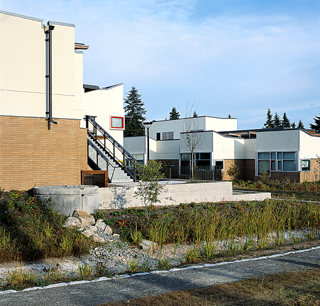|
Subscribe / Renew |
|
|
Contact Us |
|
| ► Subscribe to our Free Weekly Newsletter | |
| home | Welcome, sign in or click here to subscribe. | login |
Construction
| |
 |
September 22, 2005
Schools districts discover the value of sustainability
Integrus Architecture

Carter
|
Historically schools were a pillar of the community since they were one of the few buildings that all citizens used throughout their lives.
They were the places where children learned, families gathered and where local merchants assembled for the annual holiday bazaar. While this still holds true today, the concept of sustainable schools has vastly changed.
Twenty years ago, "building sustainable" meant constructing a facility that was efficient to operate, able to withstand large numbers of occupants and versatile enough to adapt to a variety of uses.
Now, as we look at sustainable schools we must think about the impact on future generations — will the finishes, systems and structure reduce our impact on the environment when it's installed? Will it withstand year after year of students? If materials and systems need to be replaced over time, can they be recycled?
Designing sustainably allows schools be a reflection of the community's financial commitment to its facilities.
School districts and design and construction professionals are facing increasingly complex issues, including determining what sustainability protocol must be used, whether its use will be funded by the state, what operational challenges districts may encounter with sustainable building systems, and how to integrate the sustainable building message into a school's core curriculum.
Two rating systems

Photo by Lara Swimmer/Integrus
The roofs at Terrace Park School in Mountlake Terrace are pitched to capture rainwater, which is directed into concrete cisterns. The overflow pours into swales that release water into the site's drainage system.
|
Currently there are two sustainability protocol tools available to school districts, Leadership in Energy and Environmental Design (LEED), and the Washington Sustainable Schools (WSS) protocol.
LEED, created by the U.S. Green Building Council, is a rating system to develop a consensus-based national standard for developing high-performance, sustainable buildings.
WSS was developed by a joint committee of professionals that plan, design and construct schools in Washington, with considerations for process, economics and climates unique to Washington public school districts. WSS is most useful as a goal-setting and planning tool.
WSS was created in response to a grass-roots movement by school districts and design professionals who supported sustainable design ideals, but felt the public school environment needed a protocol that would more closely correlate with the realities of school design than the LEED protocol.
Washington is now the first state to require that all state-funded projects meet or exceed a LEED silver rating. But the legislation allows public school districts, which receive only partial funding from the state, the option to use the WSS protocol in lieu of LEED.
The Office of the Superintendent of Public Instruction (OSPI) is charged with administering the protocol. OSPI will work with a group of school district representatives and design professionals over the next several months to explore development and deployment of WSS.
LEED and WSS rating systems have many similarities, but there is no reciprocity between the two systems. WSS is unique from LEED in that it awards points for:
— Siting of schools in areas of existing infrastructure
— District-wide support of high-performance policy to encourage change
— Addressing the importance of acoustic control to enhance learning
— Reusing school furnishings
— Requiring 50 percent of critical task areas to have a 2-percent daylight factor
Both systems award points for recycled materials, limiting volatile organic compounds, renewable energy sources, operable windows, reducing water consumption and controlling storm water runoff.
Change brings challenges
The greatest challenges school districts face when implementing sustainable practices often include concern for increased initial construction cost and modified facilities standards.
School districts are hesitant to consider new materials that may adversely affect their custodial or maintenance budgets.
For instance, many districts have long and successful histories with vinyl wall and floor finish products. They want assurance that an alternative "green" product will still be as durable and easy to clean and repair as their trusted standards.
Mechanical systems are one of the key drivers for energy consumption in a school. If an alternative "green" technology is to be used, district facilities groups need to know that maintenance training costs and the costs of warehousing additional spare parts are included in the life-cycle savings analysis.
Still, many WSS protocol points can be met at little or no initial cost impact through careful specification and design.
At White River High School in Buckley, for instance, an integrated design approach to lighting, including detailed modeling by Seattle's Lighting Design Lab, allowed the project to beat the state energy code requirements by over 60 percent.
Buildings as teaching tools
Perhaps the greatest opportunity school districts have to teach our next generation of leaders to be good stewards of the world they inhabit is through their example. Schools by their nature provide the optimal opportunity to use sustainable building methodologies as interpretive learning tools.
Throughout the Puget Sound region, school districts are using their school facilities as models in their curriculum.
Wetlands mitigation areas on sites are becoming outdoor biology laboratories, view windows are providing strong connections for students and staff to their outdoor environments, and daylighting is controlled and managed by sunscreens rather than just glazing, allowing students to learn about the effect of seasons on the sun's path.
We've come a long way in developing our understanding of sustainable design in only a generation, and our continued investment in its use will serve students and their communities for generations to come.
Brian Carter is a principal with Integrus Architecture.
Other Stories:
- Softening the landing for college freshmen
- Small schools best prepared to teach the new '3 R's'
- Communities play larger role in shaping schools
- How to meet new state rules and provide real value
- Top concern of every school staff: air quality
- New schools teach lessons on technology design
- Why process isn't a dirty word


